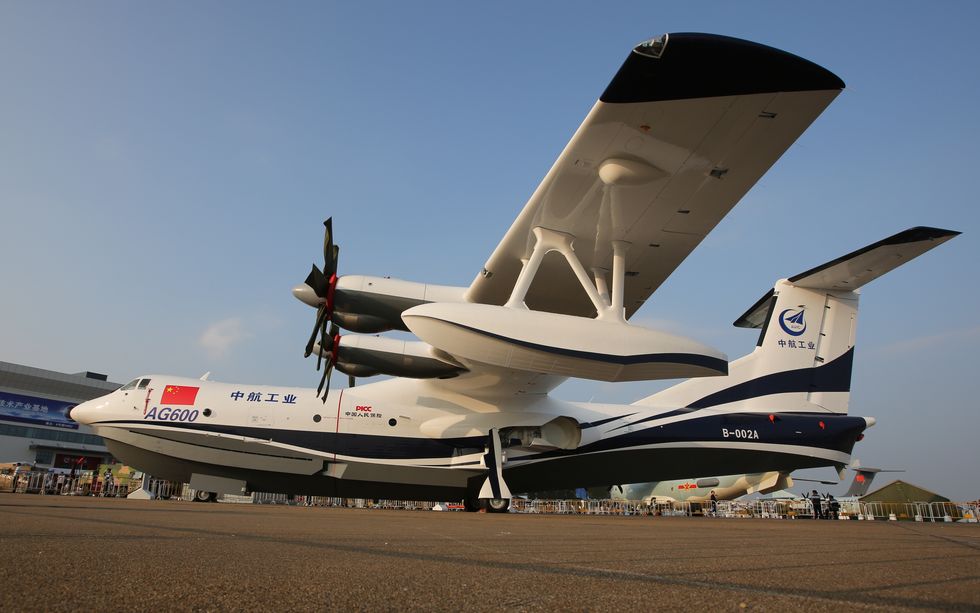- The AG600 seaplane successfully took off from the water for the first time.
- The AG600 is the world’s largest and newest seaplane, capable of taking off and landing from the sea.
- Also known as Kunlong, the AG600 is described as a firefighting and search-and- rescue plane but will almost certainly have military applications.
China’s first seaplane, the AG600 “Kunlong,” took off from water for the first time this weekend, validating the craft’s water takeoff capability. Kunlong is the world’s largest seaplane, and though Chinese state media doesn’t mention, it will undoubtedly have military applications. The seaplane will be essential, flying from the mainland to Beijing’s island bases in the South China Sea. The aircraft will also be useful locating and rescuing downed pilots in wartime.
✈ You like badass planes. We like badass planes. Let's nerd out over them together.
The AG600, according to Bejing’s Xinhua state news agency, took off from water for the first time on July 26th. The aircraft took off from the Yellow Sea, near the city of Qingdao in Shandong province. The flight took approximately 31 minutes.
The seaplane is China’s first, part of the country’s relentless expansion in the world of aviation, from jet fighters to commercial aircraft. First introduced in 2017 the AG600 is also the world’s largest seaplane, about the size of a Boeing 737. The plane is 121 feet long with a wingspan of 128 feet. The plane stands 39 feet tall. Kunlong can carry up to 50 passengers a distance of up to 2,700 miles.
China’s state media is taking pains to describe the aircraft in strictly civilian terms, describing it as suitable for “forest firefighting, marine rescue and other critical emergency rescue missions.” In the firefighting role, Kunlong can collect 12 tons of water in 20 seconds.
Here's a video from CGTN, a Chinese state media source, showing the at-sea takeoff and landing:
Despite these assertions, the AG600 will almost certainly end up in the hands of the People’s Liberation Army. The PLA is quickly transitioning from a strictly continental force to one capable of projecting power in the western Pacific and Indian Oceans, and a seaplane will enable China to maintain lines of communication to its remote island bases in the Paracel and Spratly island chains in the South China Sea.
📩 Make Your Inbox More Awesome.
The AG600, with a maximum takeoff weight of 53.5 tons, can transport personnel and equipment to places like Mischief Reef in the South China Sea. The ability to take off and land from water will allow the PLA to keep Mischief Reef supplied even if the islet’s airfield is shut down by military action. Other military missions for the AG600 would include rescuing downed pilots at sea, convoy escort, reconnaissance, and anti-submarine warfare.
The AG600 is unarmed but in a military role could carry a limited number of sensors and weapons. In the anti-submarine warfare role, the aircraft could be modified to drop sonobuoys meant to detect enemy submarines. Once an enemy submarine is located, the seaplane could drop anti-submarine depth charges and homing torpedoes to destroy the target. Another likely mission for the AG600 is dropping sea mines to close a body of water to enemy ships.
Military seaplanes were used by all of the major powers during World War II, but gradually went away during the Cold War. The role of seaplanes in the U.S. military was eventually taken over by a combination of land-based patrol aircraft and helicopters, though some argue seaplane still has a place in the Pentagon's arsenal.
Today only three countries build new seaplanes: Canada builds the Viking seaplane, Japan the US-2, and Russia the Beriev Be-200.

Kyle Mizokami is a writer on defense and security issues and has been at Popular Mechanics since 2015. If it involves explosions or projectiles, he's generally in favor of it. Kyle’s articles have appeared at The Daily Beast, U.S. Naval Institute News, The Diplomat, Foreign Policy, Combat Aircraft Monthly, VICE News, and others. He lives in San Francisco.















